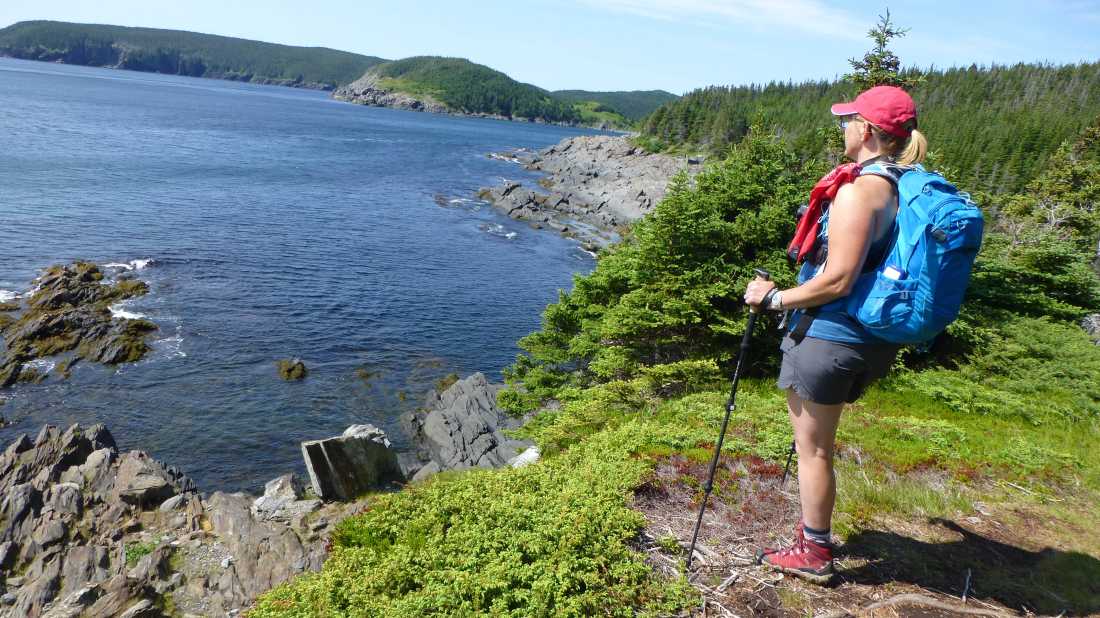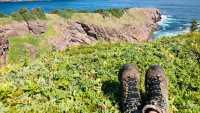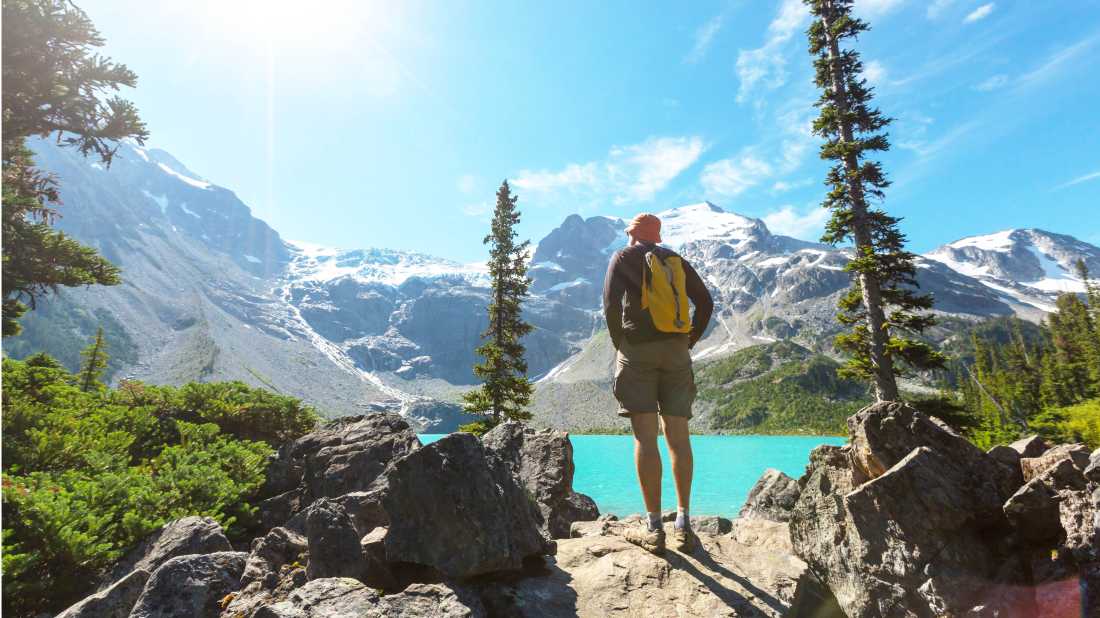Blog home / These Boots Were Made for Walking
All the support you need to find the right hiking boot
By Robin Esrock
After a week of extraordinary hiking along the East Coast Trail, admiring the Atlantic crash against the rocky cliffs of Newfoundland, my feet felt great. No blisters, no soreness, just the comfort of trusted boots that had protected my feet along the trail. It wasn't always this way. My relationship with hiking boots has been one of trial, error, and hard-won wisdom, a journey of the sole (ahem). Let’s lace up and learn from my mistakes.

Any project needs a solid foundation for success, and when it comes to hiking, the foundation is your boots. The right boot transforms a grueling hike into a dance with nature, and the wrong footwear turns a day walk into a waking nightmare. Fit is everything. I remember shopping for my first serious pair of hiking boots in a cramped outdoor store in Vancouver, confidently declaring my size to the salesperson. She insisted we measure my feet anyway. We all know sizes can swing depending on the brand, but did you know your feet swell up in the afternoon? Are you trying on boots with hiking socks you’ll actually wear on the trail? (more on socks later). When shopping for boots, you’re looking for comfort and room for your toes to wiggle. You’ll want to mimic real hiking conditions, so don’t just walk around the store, try find some inclines, stairs, or declines. The boot should feel snug around your heel and midfoot without creating pressure points. If you feel any hot spots during the fitting, imagine what they'll feel like at Kilometre 20. Hot spots don’t tend to magically disappear.
Boot brands are like different nationalities, each with their own distinct personality and fit characteristics. Salomon boots tend to run narrow and low-volume, great for slender feet but not for broader feet with high arches. Keen tend to run wide with a generous toe box, which is why they’re a sworn ally of the wide-footed tribe. Merrell is generally medium-width and a safe bet for new hikers. Columbia offers good value but tend to be less technical. Zamberlan, Grisport, La Sportiva, newcomers like Hoka and On – there are plenty of brands and hikers tend to stick with the brand that works. I have wide feet, and have long put my faith in Keens, although not all models fit the same way, even in the same brand.

New boots can also be like new relationships: you’ll need some time to adapt to each other's quirks. I once made the rookie mistake of wearing brand-new boots on a long hike up to Garibaldi Mountain in BC’s Coastal Mountains. By the end of the day, my feet looked like they'd been through a cheese grater. Breaking your boots in is critical before you take on anything ambitious. Start with short walks around your neighborhood, gradually increasing distance and difficulty. Wear them while doing errands, walking the dog, or even around the house. The key is consistency – a little bit every day for several weeks beats marathon breaking-in sessions. Pay attention to any recurring pressure points, and if you’re still feeling hot spots, consider professional stretching or padding solutions.
Modern hiking boots are marvels of engineering, and understanding technical features can mean the difference between comfort and catastrophe. Waterproofing is often the first feature hikers obsess over, because nothing kills morale like soggy feet on day two of a five-day trek. Gore-Tex and similar membranes offer excellent waterproofing but come with trade-offs in breathability. I've learned to match boots to my adventures – fully waterproof boots for wet, muddy conditions, and more breathable options for dry hiking. When in doubt, wear waterproof boots, especially in Canada! Remember, no boot is completely waterproof if water can enter from the top, so gaiters are essential for stream crossings or deep snow.
Sole construction also matters enormously. Vibram soles have become the gold standard for good reason, as they offer excellent grip on varied terrain. Look for deep and aggressive grooves for loose surfaces, and more closely spaced patterns if you expect to do rock scrambling. The midsole provides crucial cushioning and support. EVA foam is lighter and more popular, while polyurethane is more durable.
Some hikers prefer low-cut shoes, but most agree that ankle support is key. High-cut boots provide crucial stability on uneven terrain, especially if you’re carrying a heavy pack. I've rolled my ankles several times in low-cut shoes, which I packed for lightness, but never in proper hiking boots. Ankle support isn't just about boot height, it’s also about the entire construction. A well-designed boot cup cradles your heel, and when combined with proper lacing, it creates a secure platform that allows you to confidently take on challenging terrain. The support should feel natural, not restrictive.

The right boots paired with the wrong socks is like having a Lamborghini running on flat tires. My go to is merino wool, which regulate temperature, wicks moisture, and somehow doesn't stink too bad even after days of wear. I've hiked for a week with just two pairs of Smartwool socks, quickly removing them at the end of the day to let them air out. Hikers are also recommended to consider a sock system: use thin liner socks against your skin to reduce friction, covered with cushioned hiking socks. Remember to use this combination or your preferred socks when trying on new boots at the store. Whatever you do, avoid cotton at all costs, as it retains moisture and quickly loses its cushioning properties when wet or sweaty.
Proper lacing solves numerous fit issues. For boots that feel too loose around the heel, use the heel lock lacing technique to reduce friction and excess wear. This involves threading the lace through the last eyelet so that the lace comes out on the inside of the shoe, creating a loop between the last two eyelets, through which you thread the lace. For boots that create pressure on your instep, skip the offending eyelets. You can also adjust the lace set-up throughout the day if your feet swell or the terrain changes. Make sure your laces stay tight, and whatever works, stick with it. If you’ve invested heavily in your boots, regular boot maintenance can extend their life dramatically. You can remove the insoles, stuff the boots with newspaper to absorb moisture, and let them air dry away from direct heat. Regular cleaning with a soft brush removes debris that can break down materials over time.
Despite all precautions, blisters sometimes happen. Prevention is always the best path forward, by having properly fitted boots, quality socks, and paying immediate attention if you feel any hot spots. I always carry moleskin and blister plasters in my first aid kit. At the first sign of irritation, stop and address the issue. Heroic attempts to "push through" tend to result in days of misery. For treatment, drain large blisters with a sterilized needle but leave the skin intact for protection. Apply antibiotic ointment and cover with appropriate padding. Sometimes the best treatment is just a day of rest off the trail.

Your relationship with your hiking boots will evolve with every kilometre. Pay attention to how they perform in different conditions, and don't be afraid to adjust your lacing or add padding if you need to. The perfect boot isn't the most expensive or the most technical, it's the one that disappears on your feet, letting you focus on the outdoor adventure around you.
Robin Esrock is the bestselling author of The Great Canadian Bucket List and The Great Global Bucket List.